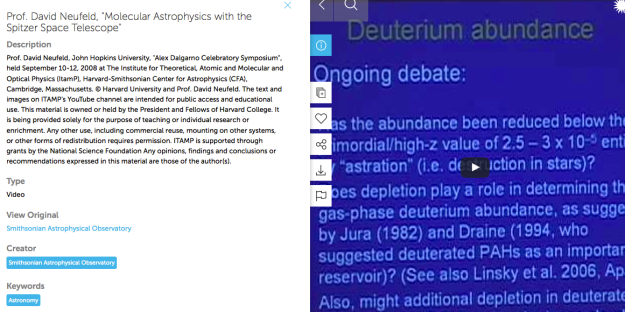 Open Education Resources (OER) have been around for some time yet few educators make use of the thousands of free resources available online, mainly due to barriers that include searchability and quality concerns. This is about to change. The next generation of OER will be on platforms that are user-friendly, intuitive and make finding and sharing Open Education Resources less time-consuming and more approachable.
Open Education Resources (OER) have been around for some time yet few educators make use of the thousands of free resources available online, mainly due to barriers that include searchability and quality concerns. This is about to change. The next generation of OER will be on platforms that are user-friendly, intuitive and make finding and sharing Open Education Resources less time-consuming and more approachable.
Open education resources is the term for digitized materials (images, lesson plans, videos, interactive learning objects, articles, even textbooks) that are offered freely and openly to educators, students and self-learners to use and re-use for teaching, learning and research (Hylen, 2006).
Two new platforms, Amazon Inspire and Smithsonian’s Learning Lab, are what I call the ‘next-generation of OER’; they have the potential to overcome the barriers associated with OER and will transform how educators teach. The platforms are the catalyst needed to bring OER mainstream—not only to reduce costs associated with learning tools but to contribute to a different mindset—a mindset where educators seek out digital resources as tools to improve learning experiences and view OER as an opportunity to expand their professional development (Orr, Rimini & van Damme, 2015).
Amazon Inspire to Launch this Fall
Amazon.com has revolutionized how we shop with its online marketplace and is bringing the technology to education with a new platform—Amazon Inspire. Inspire is in beta, the testing phase, and is designed for educators to share and find OER. It allows educators to upload, download, review lesson plans, worksheets, lesson resources, and other materials via a platform that functions similarly to Amazon.com. It’s currently focused on K-12 education, though my guess is that higher education won’t be far behind; Matt Reed from Inside Higher Ed concurs in a recent article “Amazon OER?” (Reed, 2012).
I’m optimistic about Amazon’s Inspire. When examining barriers to OER educators cite most often, it appears that Amazon’s Inspire’s features address most. Key barriers include i) time—the time needed to find appropriate resources, ii) technical skills, not only for accessing OER but contributing to the OER community, iii) concern with quality, and iv) legal concerns; uncertainty about usage rights, educators unfamiliarity with creative commons licenses for instance (Hylen 2006, Mtebe & Rasimo, 2014). Granted, there are other barriers such as institutional policies that need to be addressed for educators to integrate OER successfully, yet overcoming technical barriers will move OER forward (Hodgkinson-Williams, 2010).
Developed in support of the company’s commitment to making digital classrooms a reality, Amazon Inspire, with its rich features such as search, discovery and peer reviews, will provide educators—regardless of funding or location—access to upload and share free digital teaching resources. —Business Wire, June 27, 2016
Platforms with high visibility and robust features including how-to resources will contribute to educators viewing OER as approachable and accessible. Amazon Inspire brings awareness to OER with its high-profile brand. Most educators are likely familiar with Amazon and how it works. Amazon Inspire’s features include:
- smart-search: enables teachers to explore resources by grade level, state standard or from a particular district
- simple upload: easy-to-use and intuitive upload interface where educators can drag and drop files and add descriptions and comments
- ratings feature [this is especially significant]: It works as an open peer review where users rate a resource and add comments. This feature addresses quality concerns and fulfills a recommendation made by scholars working on OER at the Centre for Education Research and Development at OECD (Hylen, 2006).
There are criticisms from the education community about Amazon Inspire. One is that the format of a ‘marketplace’ associated with a commercial platform such as Amazon, is a detriment to OER. One comment is that a platform that is more conducive to a place where resources can ‘live’ and be adapted, similar to a platform Github for OER for instance, is more appropriate. I respectfully disagree. Moving OER forward needs platforms that are user-friendly with features that educators are familiar with and don’t require an inordinate time to learn. The next-generation of OER platforms, such as Amazon Inspire do just that.
Smithsonian Learning Lab
Another next-generation OER platform is Smithsonian’s Learning Lab. After several years of testing and revising with input from teachers and other educators, Smithsonian launched its new and improved Learning Lab. The platform appears to go even further than Amazon Inspire with features that allow teachers to create and share with students customized assignments, such as quizzes, using curated resources. Educators can add their own resources to their personal profile, and access Learning Lab’s rich bank of resources that are organized into four categories (image, video, text or learning resource). Resources are drawn from Smithsonian’s 19 museums, and nine research centers.
The platform, though geared to K-12 educators, is open to anyone interested in accessing the museum’s resources. There are resources applicable to higher education (though the search feature is an issue — details below), and Learning Lab is working with a college in Maryland to explore how faculty can use the platform so they can expand its reach and engage higher education specifically.
Learning Lab invested considerable effort in making the platform approachable based on feedback received from teachers during the testing phase. The result is the tag line “Discover, Create and Share”. A smart move. Not only for the ‘create’ aspect as mentioned, but teachers can ‘share’ using a customized link, collections or assignments with students or others via email or on social media.
There are several resources that provide users with how-to help; directions and examples in form of short videos and dedicated a help section for ‘getting started’. I do recommend signing up for an account and then learning by experimenting—trying out the various features, it’s fairly intuitive.
All good; however the down side is the search function. Searches generate resources that aren’t always applicable to the search term; for example when searching for ‘teaching with technology’ results include all resources that have the words ‘teaching’ and/or ‘technology’ associated with given resources, usually words that are embedded in its description. For example my search revealed the video below on ‘molecular astrophysics’ as the word ‘teaching’ is in the description. However, the search did produce several solid, applicable resources.

Screenshot of one of the resources resulting from search ‘teaching with technology’ on Smithsonian Learning Lab. The search function is still a challenge since the categories and descriptions of the resources weren’t written with the intent they would ever be ‘open’
According to the director of the Learning Lab, they are trying determine methods to improve the search function for users—ideas include user-generated tagging capabilities and machine image analysis.
Closing
I’m optimistic about the future of OER with the next-generation platforms. Not only because of the opportunity to reduce costs associated with learning tools, but for the effect on the mindset of teaching and learning. Educators can be empowered by OER, not only by accessing unique resources from platforms that make is straightforward, but by creating and contributing to the their own development, their students learning, and the education community.
OER Resources for Educators
- 7 things you should know about Open Education Resources, EDUCAUSE Learning Initiative
- About the Licenses, What our Licenses Do, Creative Commons
- OER Commons & Open Education, oercommons.org
- Open Education Resources: Resource Roundup, Edutopia
- Open Education Resources [listings specific to higher ed], EDUCAUSE
- A Basic Guide to Open Education Resources (OER), Commonwealth for Learning & UNESCO [a lengthy document – 134 pages, but thorough]
- Request early access to Amazon Inspire, amazoninspire/access
- Smithsonian Learning Lab
References
-
Hodgkinson-Williams, C. (2010). Benefits and challenges of OER for higher education institutions. Retrieved from
- Hylén, J (2006) Open educational resources: Opportunities and challenges. OECD-CERI. Retrieved from https://www.oecd.org/edu/ceri/37351085.pdf
- Mtebe, J., & Raisamo, R. (2014). Investigating perceived barriers to the use of open educational resources in higher education in Tanzania. The International Review Of Research In Open And Distributed Learning, 15(2). Retrieved from http://www.irrodl.org/index.php/irrodl/article/view/1803/2841
- Orr, D., M. Rimini and D. van Damme (2015), Open Educational Resources: A Catalyst for Innovation, OECD Publishing, Paris.
DOI: http://dx.doi.org/10.1787/9789264247543-en - Reed, M. (2016, February 16). Amazon OER? Retrieved from https://www.insidehighered.com/blogs/confessions-community-college-dean/amazon-oer


 ‘The List’ that provides educational resources at the finger tips—no searching, in less than three clicks—find instructive, rich content for instructional or personal use.
‘The List’ that provides educational resources at the finger tips—no searching, in less than three clicks—find instructive, rich content for instructional or personal use.


 Getting faculty to embrace open education resources takes more than directing them to a good search platform. In this post I suggest a two-pronged strategy to help faculty embrace ‘openness’.
Getting faculty to embrace open education resources takes more than directing them to a good search platform. In this post I suggest a two-pronged strategy to help faculty embrace ‘openness’. ‘Open’ as a Movement
‘Open’ as a Movement What are Open Education Resources (OER)? Where does one find open resources and under what conditions can educators use them? If you don’t have an answer to one or more of these questions, you are not alone. In fact you’re in good company. Thousands of educators across the United States, academic leaders and faculty, were surveyed for a study on open educational resources, Growing the Curriculum: Open Education Resources in Higher Education, (Allen & Seaman, 2012). Though respondents demonstrated a moderate level of awareness of OER, many were unclear on what even qualified as an open education resource. The uncertainty around OER is understandable given its newness, yet is a missed opportunity for educators.
What are Open Education Resources (OER)? Where does one find open resources and under what conditions can educators use them? If you don’t have an answer to one or more of these questions, you are not alone. In fact you’re in good company. Thousands of educators across the United States, academic leaders and faculty, were surveyed for a study on open educational resources, Growing the Curriculum: Open Education Resources in Higher Education, (Allen & Seaman, 2012). Though respondents demonstrated a moderate level of awareness of OER, many were unclear on what even qualified as an open education resource. The uncertainty around OER is understandable given its newness, yet is a missed opportunity for educators.




